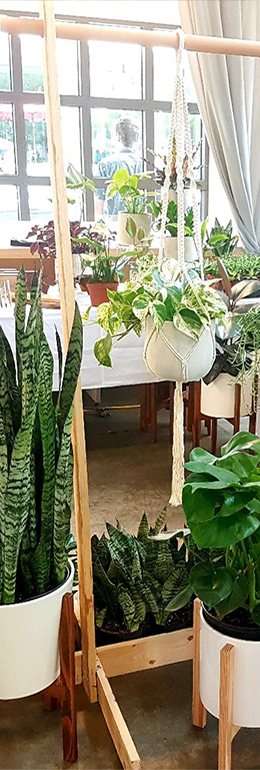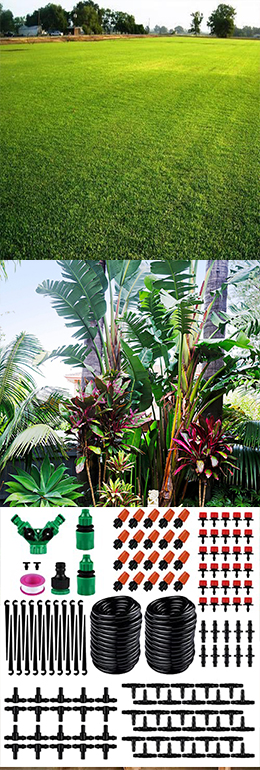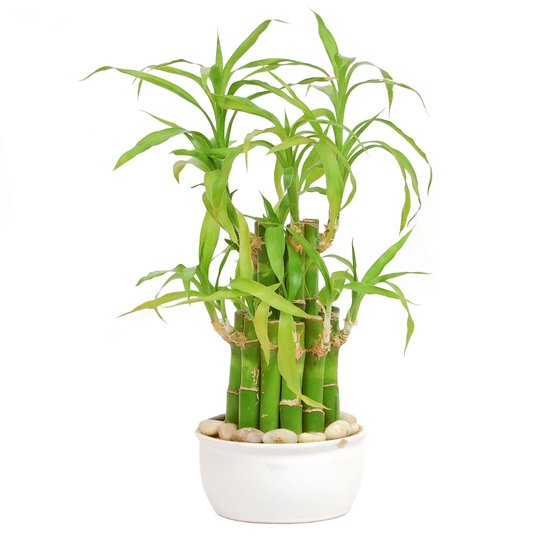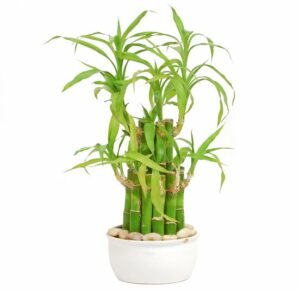How to take care of a lucky bamboo plant
Lucky bamboo has been a staple in homes and Feng Shui for years. It’s a symbol of luck and prosperity making it a common gift and the perfect small house plant. Learn more about why this plant is so popular and how you can grow one of your own. Included is information about the plant’s origin, symbolism, and FAQs, as well as lucky bamboo care tips.
Lucky bamboo (Dracaena sanderiana) is surprisingly not actually bamboo as its scientific name suggests: It’s part of the Dracaena genus. The lucky bamboo plant is from Southeast Asia and is well-known for its use in Feng Shui for over 5,000 years. In these practices, it is said to represent good luck and happiness, making it an ideal and popular gift in business and personal matters. Another factor that makes lucky bamboo so popular is its ability to be trained into shapes like a swirl, heart, braid, and other designs. See the sections below for a more in-depth look at the symbolism of lucky bamboo and how to create different bamboo designs.
Lucky bamboo is an easy plant to care for which makes it great for offices and homes alike. It’s happy growing in soil or water but has the longest life when grown in soil. Because it’s a Dracaena, lucky bamboo care is more in line with Dracaena care as opposed to bamboo. If growing in water, it should be replaced every week. If planted in soil, the soil should be kept slightly damp, so don’t overwater or let it get dry. Lucky bamboo does best in indirect light and in the temperature range of 65–95°F (18–35°C). It loves these somewhat tropical conditions and is considered to be in the hardiness zones of 10–11.
Lucky Bamboo Care Tips
It’s fairly simple to learn how to care for lucky bamboo. We’ve included in-depth information on sunlight, water, temperature, toxicity, potting, propagation needs and common pests and problems. Our quick step-by-step bamboo care guide can be seen below:
Carefully remove any packaging and add rocks to your container to act as an anchor.
- Place your bamboo in indirect sunlight.
- Fill your container with enough water to cover the roots.
- Lucky bamboo prefers a temperature range of 65–95°F (18–35°C).
- Optional: use a liquid houseplant fertilizer every three to four weeks.
- Remove any yellow leaves.
- Repot the bamboo as its roots outgrow the container.
Sunlight
Lucky bamboo requires moderate or indirect sunlight. Direct sunlight will scorch the leaves, so avoid placing your plant in front of a bright window. Scorched leaves look like how they sound: The edges of the leaves will have a brown tinge to them almost like they were burned by fire. If your leaves look a little scorched, move your bamboo to an area with less light.
Water
If growing your plant in soil, make sure it’s kept slightly damp. Don’t let the soil get too dry and don’t overwater since that can lead to root rot. Bamboo does not need much water to survive, but it can be grown in water as well. If you choose to grow your bamboo in water, make sure the roots always stay covered with water. Replenish your lucky bamboo with fresh water every seven to 10 days to keep it happy and healthy.
Algae can form in the water, so try to clean out the container and change the water regularly (about once a week). Tap water is okay for the bamboo plant to drink, as long as chlorine levels are low. To be safe, leave tap water out overnight so the chlorine can evaporate before you use it to water your lucky bamboo.
ProTip
If you have high levels of fluoride in your tap water, we recommend using filtered water, such as bottled water. Fluoride will not evaporate and is toxic to plants like lucky bamboo.
Temperatures: Lucky bamboo thrives in temperatures anywhere from 65–95°F (18–35°C), so it makes a great office or house plant. During colder months, be wary about leaving your plant near windows or other places with a cold draft.
Toxicity
Lucky bamboo is toxic for cats and dogs, so make sure to keep it out of reach. If consumed by your fur babies it can cause incoordination, weakness, vomiting, abdominal pain, diarrhea, drooling and dilated pupils. Lucky bamboo is not toxic to humans, however.
Pests
Some common pests that affect lucky bamboo include mealybugs, mites and fungal infections. If you notice grey fuzz on your plant it could be a fungal infection, so remove the infected growth, keep the stalk and leaves dry, and increase air circulation. Mealybugs are small white insects that should be removed manually and with rubbing alcohol. Although mites (presented as white webbing or fuzz) don’t typically affect lucky bamboo, they can be caught by other household plants. They need to be eradicated with water and dish detergent — see plant disease treatments for more detail.
Problems
Your lucky bamboo should be green, but if any part of the stem or leaves are yellow, this indicates your plant could be sick. Remove the yellow part of the stem or the leaves completely so it doesn’t spread to the rest of the plant.
Repotting
How do you know when to repot your bamboo? You should repot once the roots become too tight in the container. Once you see the roots crowding, move the bamboo to a larger container. If your plant is growing in just water, simply move it to a new vase. If you’re using rocks, dump them out, place your plant in the new container (or trim back the roots to use the same container) and replace the rocks. If you’re using soil, dampen the soil, flip the plant with your hand on the stalks and soil to remove the plant, and move it to a larger pot.
Propagation
To propagate a lucky bamboo plant, first identify a healthy parent stalk (should have more than two bamboo segments) with an offshoot. Clip the offshoot from where it connects to the parent plant stalk and remove its bottom layer of leaves to create a new independent stalk. Place the new stalk in a small container of water and nurture the plant as you would a larger one. Repot as needed.

 العربية
العربية



